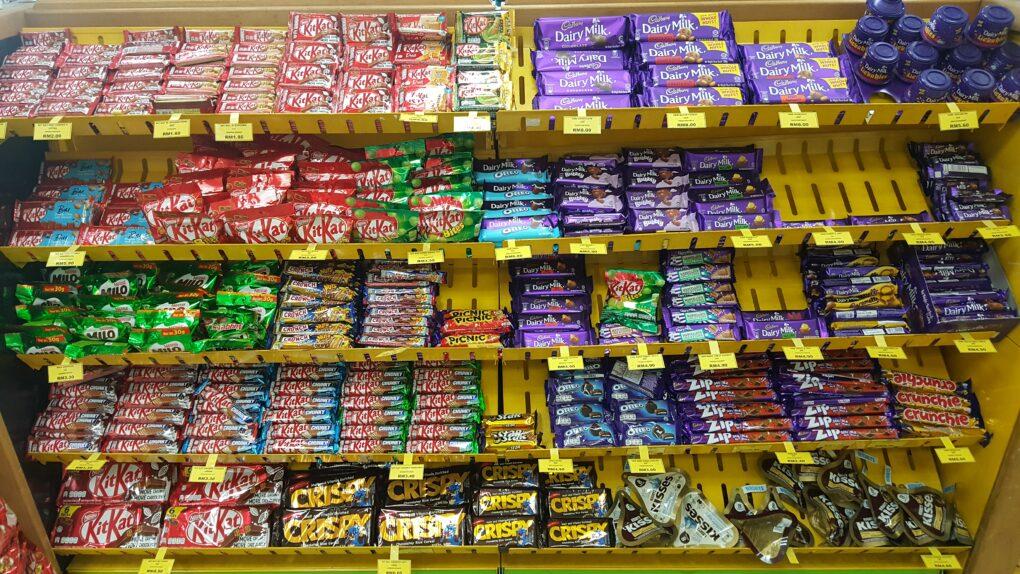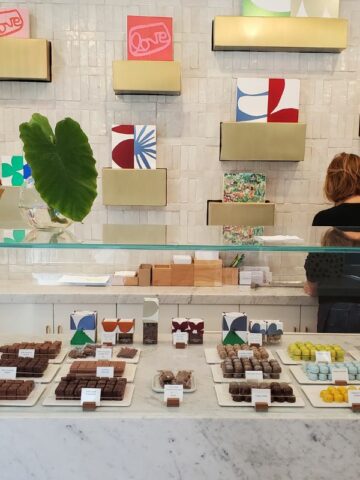Flying into Kuala Lumpur, all you can see from above are oil palm trees, an emerald green that's quietly choking Malaysian forests. These trees bear the fruits from which palm oil is extracted, and they don't invite company, a fact which has proved fatal for Malaysia's biodiversity.
The land surrounding Kuala Lumpur used to be covered in cocoa-populated forest, visible from miles above. But cocoa production levels have now dropped from one of the top ten in the world to just a few thousand tons per year, nothing compared to the millions of tons coming out of West Africa.
Cocoa processing is now the big industry, with Malaysia importing much more cocoa than it exports. There are still large pockets of cocoa growing across the country, mostly on Malaysian Borneo, but it's a dying industry.
To judge its future in the face of competing crops, it's important to understand Malaysian consumption habits, as well. There's a divide between eastern and western Malaysia that goes beyond the physical; it's like stepping into a different country when you travel between the two.
Yet their agricultural sectors remain quite similar, now dominated by durian and oil palm and rubber, all for export. Of the main plant-based products coming out of Malaysia, only the cocoa they process is no longer grown predominantly in Malaysia.
Yet locals are still proud of Malaysian chocolate, fixing their taste memory around the palm oil-blended sweets most commonly found on supermarket shelves, and making it remarkably easy to find a chocolate shop. Malaysia might even initially seem like a chocolate destination by now, but it isn't. Not yet.

Jump To
History of Cacao in Malaysia
Malaysia has been growing cacao for more than two centuries; the first recorded pods were found in a garden in Malacca in 1778. The fruit is believed to have been brought to the shores via Sri Lanka— then called Ceylon— in 1770.
Those Sri Lankan pods were likely themselves from Brazil, originally. The Portuguese and the Dutch had built up the city of Malacca at the time, until a war with the Netherlands allowed the Malay people to take it back.
During the next century-and-a-half of British rule, Malaysia would come to be a world power in cocoa production, remaining in the top ten producers for decades. World War II greatly interrupted that trajectory, while rising demand from Europe increased cultivation after the war's end.
This was especially impactful in the regions of Sabah and Sarawak, in Malaysian Borneo. Up until about thirty years ago, Kota Kinabalu in Sabah was one of the main cocoa-producing areas in the world. But then, CPB appeared.
The cocoa pod borer, also known as CPB, hardened cocoa fruits and lowered production quantity across Malaysia. Eventually farmers were discouraged enough that many replaced their cocoa trees with other things; larger plantations often replaced their crop with oil palm trees.
By then, Malaysia was one of the world's top cocoa processors, so the country's cocoa imports steadily rose even as their cocoa production decreased. These days, the most common crops around Sabah are oil palm, rubber, coffee, and smaller amounts of cocoa and tea.
Of these crops, the hardest to grow is still cacao. The maintenance alone is an enormous responsibility, but so is convincing farmers to return to growing cocoa.

The Malaysian Approach to Cacao
Although many farmers cut their cocoa trees to replace with other crops back in the 1990's, some farmers simply couldn't afford to. This left thousands of cocoa trees abandoned across the country, some for decades.
Of those existing patches, most are cocoa-only, though some have integrated durian or coconut or other cash crops in there. According to Ning-Geng Ong, founder & cocoa grower at Chocolate Concierge, Malaysia's long history with cacao has made it more like a native crop.
"If you brave the leeches, you could see cacao trees in Malaysia in the wild," he says." Agroforestry-style growth is becoming more common across the country, and has potential for increasing farmer income without forcing them to grow only cocoa.
It also makes for more interesting micro-lots of cacao for small-batch chocolate makers like himself. Since embarking upon this Malaysian chocolate experiment, Ning has introduced this wild method of cultivation on his own farms, inspired by the approach of the indigenous groups he works with.
Some of the crops he's introducing include native plants under threat of extinction.

Unfortunately, Ning's forward-thinking approach is far outside of the norm. Most cocoa grown in Malaysia is still inconsistently fermented. This stems from the fact that most farmers sell to middlemen or cocoa processing centers offering a fixed low price.
This offers no incentive to farmers to ferment well. In fact, most farmers merely drain the liquid off their cocoa once they scoop it out of pods, a ferment-by-default that lasts only two to three days before the seeds are left to dry.
Part of the reason for these low prices is that the farmers who had the means to switch crops in the eighties and nineties did so long ago. The farmers still left with cocoa are usually poor, either caring for trees because it's all they have or ignoring them in favor of other work.
For farmers like Rustam Bakka, born and raised on Borneo, abandonment wasn't an option— the cocoa was there, so they cared for it and sold it, and continue to do so. Rustam is now a regional cocoa buyer from farms around his home in Keningau, as well as the main fermentation manager.
As a child, he remembers sucking on the pulp of the cocoa fruits grown on his uncle's farm, where he was raised after his parents passed. He never tried commercial chocolates as a child. The closest he came was a glass of malted cocoa drink Milo, which he tried for the first time at age 13.
Despite the numerous cacao-derived products being made in Malaysia, the most rural cocoa farmers still don't consume chocolate products. They'll eat the fruit like a fruit, but the appeal of the chocolates widely available in Malaysia is lost on them.


The Knowledge Center of Asian Cocoa
Despite declining levels of cocoa production and processing, Malaysia remains one of the top cocoa knowledge centers in the world. For decades the government's not only maintained a strong genetic bank of cocoas, but they've worked with other Asian nations like Vietnam and Thailand to discover the ideal varietals of cocoa for their land conditions.
Headquartered in Kota Kinabalu, a city in eastern Malaysia, the Malaysian Cocoa Board now has outposts across Malaysian Borneo, with a few on the peninsula. They also maintain the 4th-largest library of cocoa genetics in the world, and most countries in Asia can connect their cacao species back to a Malaysian-born varietal.
All the six or seven farms I visited in Malaysia had several types of cacao; most farmers grow at least 6 distinct varietals, especially after what happened with pests in the eighties and nineties. Most of the research into ideal cocoa types and soil conditions has been carried out by the Cocoa Board, whose primary purpose is to encourage farmers to plant cocoa anywhere they can.
The Board supports these farmers by teaching them how their cacao can produce better, and connecting them to local cocoa buyers. Most all farmers have access to mobile phones, so the Board uses this to their advantage by sending daily cocoa prices out via text message.
Beyond that, they share information about properly fertilizing trees. This information is then shared and discussed in farmers' WhatsApp groups, locally-based crews of farmers which can be well beyond 100 members.
"Most Malaysians are farmers from way back, and they have their own ways of farming without chemicals," says a higher-up at the Board.

While the majority of Malaysian farmers still don’t fully ferment their cacao, they’re now realizing that fermentation is important for accessing a living wage as a cocoa farmer. While there are consistent prices advertised by the Cocoa Board for each region of Malaysia, even that's not really the prices farmers get.
Most growers must sell to middlemen to get their cacao to the faraway collection centers, lowering income further. Current commodity price is well under $2USD per kg— as of November 2019, the collection center was offering $1680USD per ton.
The price difference can grow dramatically from there, with the premium market paying 2-4x the commodity price, but being remarkably harder to access. Since commodity prices aren't going to rise overnight, the Board has shifted its focus.
They're now working with farmers to not only increase quality and quantity, but to fully realize the concept of “farm to table” production in Malaysia. This idealizes that farmers who properly ferment and dry their beans will be able to partner with higher-paying processors who are producing higher quality products in Malaysia.
While the farmers I met with in Malaysia were able to do this, I was only able to meet with them because they'd already done it; for most farmers it's still a dream.

Craft Chocolate in Malaysia
While there are at least a dozen small-scale chocolate makers in Malaysia, industrial chocolate is still overpowering the specialty industry. One local chocolate maker explained to me that Malaysians love chocolate, but they're so used to "crap chocolate" that it's a one-by-one effort to flip them towards craft chocolate.
When Josephine Lu, founder of Borneo-based Jaws & Claws Chocolate, was a child, imported chocolates were a special treat. Cadbury and Van Hauten were the most popular, while these days the locally-made compound chocolates are absolutely everywhere.
The most popular chocolate products in Malaysia right now are milk chocolate-based, likely some kind of confectionery or molded solid chocolate, based on my interviews and observations. Then there's Milo, the ever-present Australian beverage that Rustam tried first at age 13; the company even sponsors signs for restaurants around the country.
Craft chocolate creations such as chocolate bars and bonbons haven't quite caught on yet.

In the sphere of Asian chocolate, Malaysia is kind of a "black hole," according to Ning (from Chocolate Concierge). Even though there are lots of makers throughout Southeast Asia, the Malaysian craft chocolate scene has been very quiet.
But don't mistake diligence and dedication for absence. Beyond his work with agroforestry in Malaysian cacao on indigenous tribal land, Ning is supplying cocoa to around a dozen chocolate makers across the world. But his goal isn't to sell Malaysian cacao en masse. He just wants to produce high quality cacao and chocolate, and make it possible for others to make a living farming cocoa.
As the crop has become more like a native species, it's increasingly heartbreaking to see it cut down and replaced with crops that choke the very air we breathe. During the decades of decline in Malaysia, cocoa production has increased in neighboring Indonesia, with potential for larger production in nearby Cambodia and Myanmar.
"Cocoa always goes to the more cheap place," says Eddie Kim of Bonaterra Chocolate. Nobody wants farmers to abandon a crop with so much history and generational knowledge, not to mention relatively less environmental impact, but it's still happening.
The only places where cultivation is picking up is where there are chocolate makers working directly with farmers to bring quality up to a global high standard. Far in the future, if all goes well then Bonaterra will be able to do for Malaysia what Marou has done for Vietnamese cocoa— make you want it.

The Future of Cocoa in Malaysia
Cacao’s biggest competitors on Borneo are oil palm and durian, and it's about the same on peninsular Malaysia. Both crops are generally grown by themselves, without bio-diverse surroundings, and to great profit.
“It’s a threat to the industry,” says my source at the Malaysian Cocoa Board. For the farmers who choose to switch crops, it's not a gradual change; all their cocoa will be cut.
"The Malaysian grower cannot survive at prices that are coming out of Africa. The living standards are different; labor costs are different."
Ning-Geng Ong, Founder & Cocoa Farmer at Chocolate Concierge
If Malaysian cacao production is to bounce back, it must be a thoughtful resurrection. As the Malaysian Cocoa Board continues to push this concept of "farm to table" and partnering with chocolate makers, it's clearer than ever that rebuilding the cacao industry will not be as instant as cutting it down has been.
Commodity cacao prices don't change overnight, so the creativity must be in the approach. The trend of farm-to-table and artisanal foods might be exactly what farmers need. The problem is scaling it all.
The concept behind farm to table already exists in the local language, finding purchase in the Malay idea of hulu and hilir, meaning "upstream" and "downstream." The farmers getting $1.70USD or less per kg of dried cacao are nowhere in this mock-up of farm-to-table. They can't even see the metaphorical table.
As helpful as the Cocoa Board may strive to be, they're not the ones making products with that cocoa. Each effort to bring back Malaysian cacao production originates with a single creative person, like Ning or Rustam or Josephine or Eddie, all of whom I interviewed for the Malaysia episode of Chocolate On The Road.
These are the people bringing single origin Malaysian beans to market, and finally bringing a seat for farmers at the table. And everybody's ready for a meal.

















Django Moon
Interested to know the type of cacao grown in Malaysia (criollo, forestero, trinitario) and whether there are people selling 100% pure cacao in blocks (often referred to as ‘ceremonial cacao’). It’s an expanding niche market, the major sources being Peru, Guatemala and Bali.
Max
Since Malaysia is the base for cacao research in Asia, there are countless clones being grown throughout the country, but there are definitely people selling cacao in blocks. The problem would be to find a company using properly fermented cacao, as the prices paid to farmers is quite low in Malaysia, so many farmers don't bother to ferment their cacao at all.
Gerard D'Cruz
Cocoa production in Malaysia has been deciminated because of a pest, the cocoa pod borer and a disease, the vascular streak dieback. Used to work (clear jungle, plant and help manage) the world's largest cocoa estate or plantation of 20,000 acres in Sabah.
Gerard D'Cruz
@Django Moon,
Mostly Amelonado.